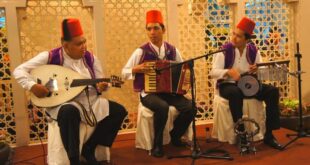by ASIFF HUSSEIN
 Sesath or traditional Sinhalese umbrellas have a long history behind them. Although today largely used as home decor and at ceremonial observances such as peraheras, the sesatha of yore had a functional as well as a ritual value. The olden-day sesath appear to have been invariably white as is suggested by the term sesatha itself which is derived from the Sanskritic shveta-chatra or ‘white umbrella’. Such white umbrellas are said to be still found in the homes of old Kandyan families. Besides serving as a sunshade borne by the attendants of aristocracy, the sesath could also be said to have indicated a man’s status in society.
Sesath or traditional Sinhalese umbrellas have a long history behind them. Although today largely used as home decor and at ceremonial observances such as peraheras, the sesatha of yore had a functional as well as a ritual value. The olden-day sesath appear to have been invariably white as is suggested by the term sesatha itself which is derived from the Sanskritic shveta-chatra or ‘white umbrella’. Such white umbrellas are said to be still found in the homes of old Kandyan families. Besides serving as a sunshade borne by the attendants of aristocracy, the sesath could also be said to have indicated a man’s status in society.
Ancient clan
The making of traditional sesath today survives in only one solitary village, namely, Unaveruva in the Asgiriya Udasiyapattu Korale of Matale district. Here, an ancient clan known as the Vellidura who are said to have arrived with the sacred Bodhi tree from India during the time of King Devanampiya Tissa still manufacture these age-old sunshades for a livelihood, and all indications are that the industry here is a thriving one.
Tradition has it that the villagers are descended from one Dinumutu Valliya who settled in Divilla not far from Unaveruva. His descendants however moved on to Unaveruva and with time four families sprung up, namely, Kira Durayale Gedara, Pusumba Durayale Gedara, Komala Durayale Gedara and Pancavatte Gedara. What is surprising however is that the art of making sesath was kept a closely guarded secret until about four decades ago by just one solitary individual, namely, Komala Durayalegedara Mutingia and was in danger of being lost to posterity had it not been for the untiring efforts of a kinsman of his, Kira Durayalegedara Lokukiriya, who having surreptiously learnt the craft passed it on to the rest of the villagers.
utingia,it is said, worked only at night and Loku Kiriya having befriended him would sleep in his house. While pretending to be asleep, he would closely observe Mutingia working on his sesath from under his bedcover and after careful observation he finally learnt the secret which he taught the other villagers so that all could enjoy its fruits rather than just one selfish individual who had jealously monopolised the trade until then.
Majestic sunshades
The art of making sesath is no longer a jealously guarded secret today and the villagers whom we met including Loku Kiriya’s only son K.D.G.Nandasena and others such as K.D.G.Gunaratna and G.D.Nandavati were only too eager to offer us information on how these majestic sunshades were made.
The raw materials used for the manufacture of sesath are indeed very few and include the leaves of the tala or corypha umbraculifera palm,the inner bark or fibre of the cocoa tree, mica and dyes of various colours. The tala leaves and cocoa fibre are obtained from nearby areas while the mica is largely purchased from Madavala where it is brought from Eppavala. Although this mineral was formerly sourced from Talagoda, this is no longer possible due to its scarcity there. The dyes are also purchased from outside sources.
Although only artificial dyes are used today, Nandasena recalled that in the olden days they employed natural dyes such as patinga for red, boiled kos wood for yellow, the dried extract of maditiya leaves for green and the bark of endaru and puvak for black. The transition of natural dyes to artificial ones was a gradual process, he observed.
Once all the necessary raw materials have been obtained, the first step consists of boiling the tala leaves in water to rid it of its acridity after which it takes on a whitish hue. The leaves are once again boiled in dye to obtain the necessary colours, after which it is dried in the wind and cut into strips. Some are left as they are and some are plaited before being sewn along with the sheets of mica to form the necessary designs, cocoa fibre being invariably used for the sewing. Among the more common motifs used are the Nelum mala or stylized lotus flower which adorns the centre and the Palapetta made of plaited tala leaves which decorate the outer circles.
The sesath are usually produced as mala hate sesath with seven circles, mala pahe sesath with five circles and mala tune sesath with three circles, their sizes ranging from 13 to 18 to 28 inches. These sesath once finished are affixed to laquered poles some of which are produced in the village itself and the product is finally ready for sale. The greatest demand today is for the mala hate sesath which is used for home decor and other purposes though the rest too have a sizeable market.
 Asiff Hussein – Asiff Hussein Web Site
Asiff Hussein – Asiff Hussein Web Site




